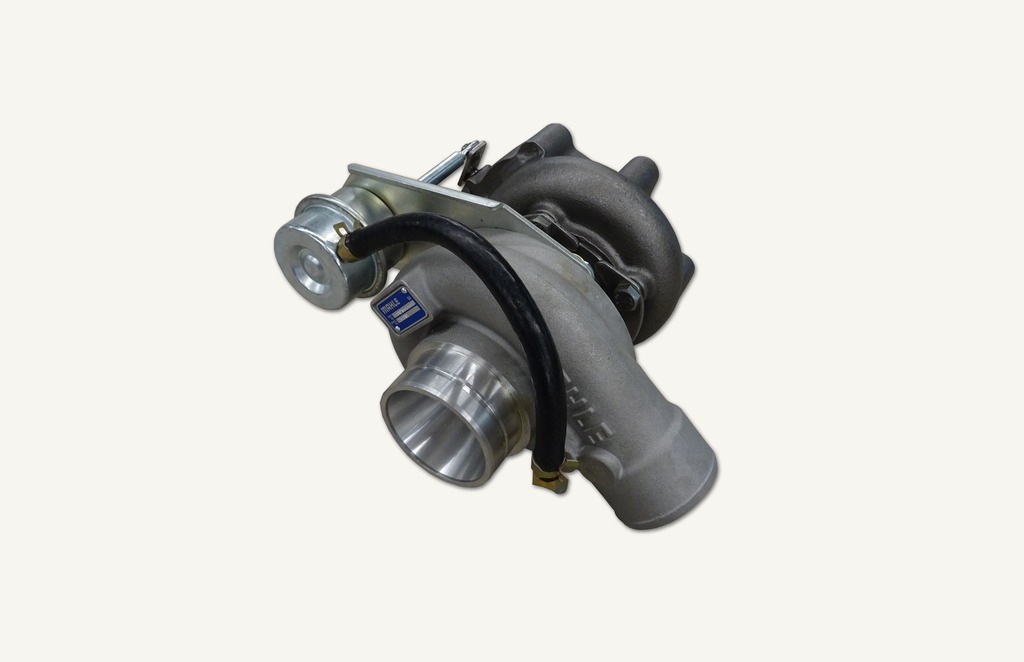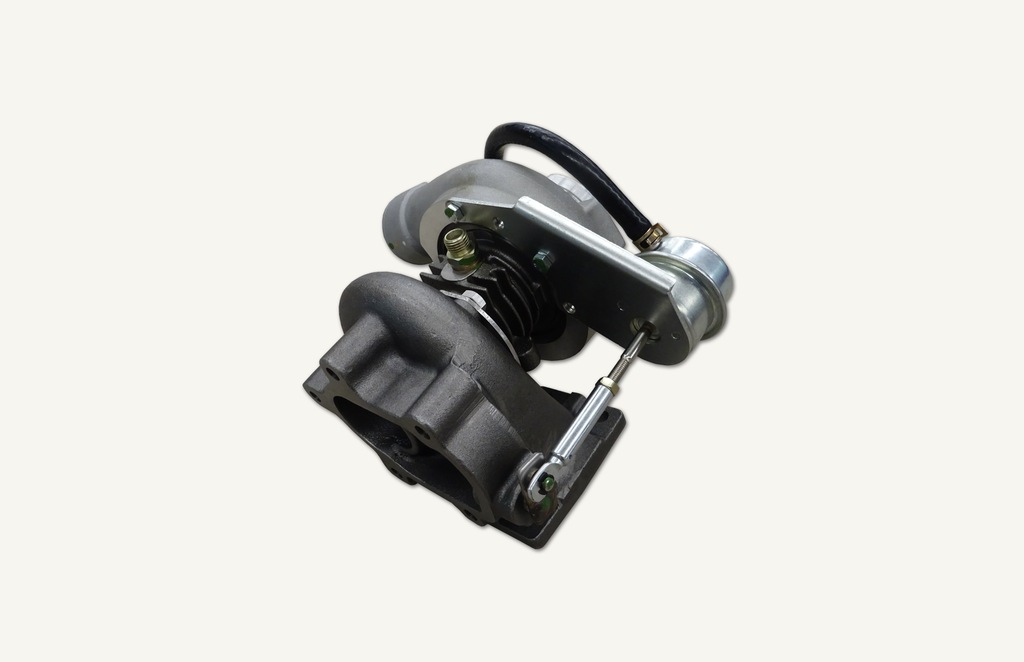CHF 1,071.20
CHF 1,071.20
excl. VAT
Not Available
This combination does not exist.
Units of Measure: Units
Add to basket
Product information:
Attention :TL70A TL80A
3 different turbos were installed:
1053206
1017306
1053442
ATTENTION:
Check the diameter of the intake pipe connection. There are two variants, with 48mm and 59mm
Important:
Oil pressure must not be below 4.5 bar but also not above 6 bar.
(not below 4 bar even when idling)
Oil flow rate for turbo return line at least 1 litre per minute
1 Lack of lubrication
Lack of lubrication is one of the most common causes of turbocharger failure. If the turbocharger is supplied with too little oil, damage will occur within a very short time. The reason for this is the very high speeds of the turbocharger.
EFFECTS
The compressor and turbine wheel can strike the turbocharger housing due to bearing damage (Fig. 1). This can be recognised by the tarnish marks on the housing (Fig. 2). If the turbocharger boost pressure is too low, the engine has a lack of power: The running gear no longer reaches the maximum speed and can therefore no longer build up the full boost pressure. The reason for this is the mixed friction caused by the lack of lubrication.
Black smoke comes out of the exhaust system. These are the effects of an undersupply of air to the engine and a fuel-air mixture that is too rich. The shaft shank is clearly discoloured (Fig. 3). This is caused by friction and the resulting high temperatures between the shaft and the bearings. The cause is a lack of lubrication. If the temperature exceeds a certain value, this results in
If the temperature exceeds a certain value, the bearing material welds onto the shaft (Fig. 4) or even completely welds the bearing bush to the shaft. A broken shaft (Fig. 5) is the result of prolonged operation of the turbocharger with a lack of oil. This can cause the shaft material to anneal and break.
2 Contaminated oil
Dirt, soot, fuel, water, combustion residues or metal abrasion can contaminate the oil. Due to the extremely high speeds of the turbocharger, even the smallest particles in the oil can cause severe damage to the turbocharger.
EFFECTS
The smallest foreign particles in the oil cause scoring in the bearing bushes (Fig. 1). The piston rings in the turbocharger can become severely worn. As worn piston rings can no longer seal the turbocharger sufficiently, the oil enters the turbine side. This can be recognised by increased oil consumption. The bearing play of the impeller increases due to the worn bearing bushes. This leads to wobbling movements and to the turbine or compressor wheel running against the housing (Fig. 2). The shaft can then break off.
The bearing collar, i.e. the thrust bearing thrust washer, is scored.
Scoring or seizure marks are visible in the thrust bearing. A blocked oil return line means that the oil in the turbocharger can no longer flow out and is instead forced out to the compressor and turbine side. On the turbine side, the oil can then burn onto the shaft and coke (Fig. 3). The bearing housing and the piston rings can then be severely worn due to the layer of oil carbonisation. The turbocharger shaft shows clear signs of wear at the bearing points (Fig. 4).
CAUSES
If the maintenance intervals are exceeded, the oil filter can no longer filter sufficient dirt out of the oil. In this case, the dirt particles enter the engine circuit through the open bypass valve of the oil filter. If the engine is operated with a clogged oil filter, the small abrasive particles cannot be filtered out of the oil. If the cylinder head gasket or the radiator is leaking, water enters the oil circuit and dilutes the oil. This reduces its load-bearing capacity. If the engine has been repaired but not properly cleaned before reassembly, the dirt will already be in the engine before it is started up for the first time. The charge air cooler has not been replaced. Accumulated engine oil, swarf or fragments from the previous damage usually enter the engine with a time delay. If the engine is subject to heavy wear, the mostly metallic wear particles also enter the turbocharger via the oil circuit. If combustion problems occur in the engine, unburnt fuel can enter the oil. This dilution reduces the load-bearing capacity. If bearing bushes permanently installed in the bearing housing are welded to the shaft, the bushes can twist in the bearing housing (Fig. 6). The shaft can suddenly block in the bearing housing due to mixed friction. If this sudden blocking of the running gear occurs, the locking nut of the compressor wheel may come loose. The running gear can become highly unbalanced as a result of running against the housing. As a result, there is a risk of the radial bearing breaking (Fig. 7). The bearing housing can become coked due to incorrect oil or hot setting of the motor. The radial bearings have seized. The thrust bearing shows signs of seizure or oil carbon deposits. Worn bearings can cause excessive wobbling of the shaft
which can also damage the bearing collar.
4 Oil leakage at the turbocharger
If the engine shows increased oil consumption and smokes blue, the turbocharger should definitely be included in the root cause analysis. Important: Oil is only forced out of the housing of a turbocharger if the operating conditions around it are different.
EFFECTS
Oil is forced out of the turbine or compressor side of the turbocharger.
Blue smoke escapes from the exhaust system.
Engine oil has collected in the intake tract and charge air cooler.
The engine is losing power.
Uncontrolled overspeeding (so-called ‘revving up’) occurs in the engine due to the engine oil that has collected in the charge air cooler, which is blown into the engine intake and burnt.
In a VTG turbocharger, the guide vanes may be clogged.
CAUSES
If the oil return line of the turbocharger is blocked (Fig. 1) or constricted by a kink, the oil can no longer drain from the turbocharger (Fig. 2, sketch B). A possible cause of a blocked oil return line is coking of the return line, which can be caused by missing heat shields, a poorly laid return line, hot engine shutdown, poor oil quality or the use of liquid sealant. As the turbocharger continues to be supplied with oil from the engine circuit, the oil then presses towards the turbine or compressor.
the turbine or compressor side.
If the engine is filled with too much oil, the oil from the oil return line of the turbocharger can no longer flow back into the oil pan (Fig. 2, sketch C). In addition, the crankshaft puddles up the oil. This creates oil foam, which forms an additional barrier for the returning oil from the turbocharger (Fig. 2, sketch D).
If the pressure in the crankcase is too high - either due to excessive blow-by (Fig. 2, sketch E) or due to a blocked crankcase ventilation (Fig. 2, sketch F) - this pressure is also transferred to the oil return line of the turbocharger. As a result, the oil drain from the turbocharger is obstructed and the oil pushes out of the turbine or compressor side.
Checkout



